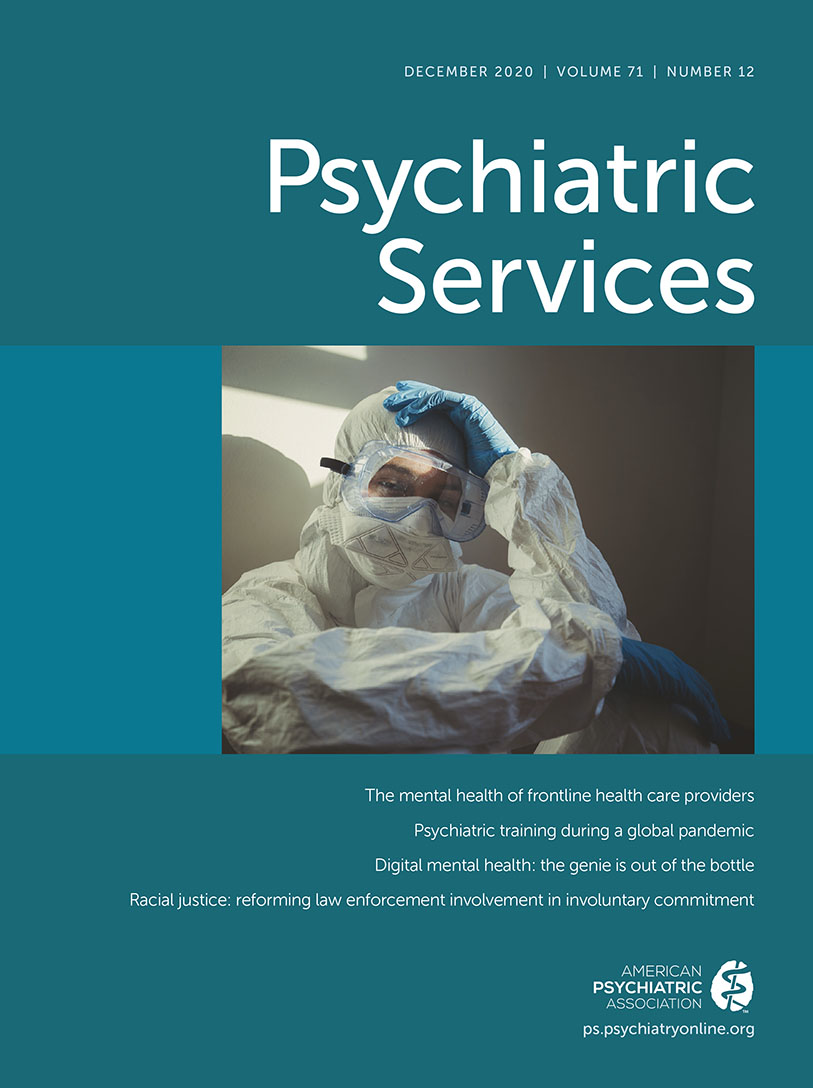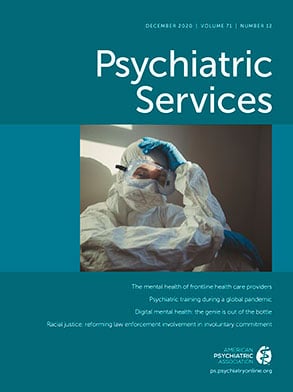Augmenting Evidence-Based Care With a Texting Mobile Interventionist: A Pilot Randomized Controlled Trial
Abstract
Objective:
Methods:
Results:
Conclusions:
HIGHLIGHTS
Methods
Participants
Random Assignment and Blinding
Intervention Description
Measures
Feasibility.
Acceptability.

Clinical effects.
Analytic Approach
Results
| Total (N=49) | Mobile interventionist (N=37) | Treatment as usual (N=12) | ||||
|---|---|---|---|---|---|---|
| Characteristic | N | % | N | % | N | % |
| Female | 22 | 45 | 15 | 41 | 7 | 58 |
| White | 24 | 52 | 17 | 49 | 7 | 64 |
| Black/African American | 12 | 26 | 10 | 29 | 2 | 18 |
| Multiracial | 8 | 17 | 6 | 17 | 2 | 18 |
| Hispanic/Latinx | 6 | 13 | 3 | 8 | 3 | 25 |
| Schizophrenia | 19 | 39 | 17 | 46 | 2 | 17 |
| Schizoaffective disorder | 11 | 22 | 9 | 24 | 2 | 17 |
| Major depressive disorder | 7 | 14 | 4 | 11 | 3 | 25 |
| Bipolar disorder | 12 | 24 | 7 | 19 | 5 | 42 |
| M | SD | M | SD | M | SD | |
| Age | 44.8 | 11.2 | 45.4 | 11.1 | 43.3 | 12.0 |
| Education (years) | 12.9 | 3.0 | 12.8 | 2.4 | 13.1 | 4.5 |
| Lifetime hospitalizations | 2.8 | 3.0 | 2.8 | 3.4 | 2.7 | 1.7 |
| Past-year hospitalizations | .4 | .6 | .4 | .6 | .3 | .5 |
| Mobile interventionist | Treatment as usual | ||||||||
|---|---|---|---|---|---|---|---|---|---|
| Measure | M | SD | M | SD | t | df | p | Cohen's d | 95% CI |
| PSYRATSb | |||||||||
| Baseline | 19.6 | 20.4 | 5.2 | 11.2 | 2.32 | 47 | .03 | ||
| 3 month | 15.1 | 16.7 | 6.2 | 14.4 | .18 | 34 | .86 | .06 | −.61, .73 |
| 6 month | 17.9 | 19.1 | .6 | 1.9 | 1.63 | 39 | .11 | .62 | −.15, 1.40 |
| GPTS–persecutory ideation subscalec | |||||||||
| Baseline | 38.4 | 20.6 | 25.7 | 10.6 | 2.05 | 47 | .047 | ||
| 3 month | 36.6 | 19.6 | 41.5 | 20.7 | –1.80 | 30 | .08 | −.61 | –1.31, .08 |
| 6 month | 36.9 | 20.5 | 22.5 | 14.2 | 1.04 | 36 | .30 | .40 | −.38, 1.17 |
| BDI-IId | |||||||||
| Baseline | 18.5 | 13.7 | 18.5 | 11.4 | .00 | 47 | 1.00 | ||
| 3 month | 17.2 | 11.3 | 23.4 | 12.4 | –2.05 | 30 | .049 | −.63 | –1.25, −.002 |
| 6 month | 15.5 | 11.2 | 14.8 | 10.3 | .22 | 33 | .83 | .07 | −.57, .71 |
| BAIe | |||||||||
| Baseline | 21.9 | 14.0 | 18.9 | 13.3 | .66 | 47 | .52 | ||
| 3 month | 19.7 | 12.9 | 22.0 | 15.5 | −.49 | 37 | .63 | −.17 | −.87, .53 |
| 6 month | 20.7 | 12.5 | 18.3 | 9.9 | .09 | 36 | .93 | .03 | −.63, .69 |
| IMRSf | |||||||||
| Baseline | 48.8 | 9.0 | 48.8 | 7.5 | .03 | 47 | .98 | ||
| 3 month | 47.8 | 9.7 | 43.3 | 6.5 | .58 | 31 | .57 | .23 | −.59, 1.05 |
| 6 month | 51.6 | 9.6 | 51.6 | 9.8 | .11 | 32 | .92 | .04 | −.68, .76 |
| RASg | |||||||||
| Baseline | 89.8 | 17.3 | 91.8 | 14.6 | −.35 | 47 | .73 | ||
| 3 month | 92.9 | 15.5 | 90.0 | 13.8 | .85 | 34 | .40 | .24 | −.33, .80 |
| 6 month | 94.4 | 14.9 | 93.8 | 13.1 | .43 | 32 | .67 | .15 | −.55, .85 |
Feasibility
Acceptability
Clinical Effects

Discussion
Conclusions
Acknowledgments
Supplementary Material
- View/Download
- 32.02 KB
References
Information & Authors
Information
Published In
History
Keywords
Authors
Competing Interests
Funding Information
Metrics & Citations
Metrics
Citations
Export Citations
If you have the appropriate software installed, you can download article citation data to the citation manager of your choice. Simply select your manager software from the list below and click Download.
For more information or tips please see 'Downloading to a citation manager' in the Help menu.
View Options
View options
PDF/EPUB
View PDF/EPUBLogin options
Already a subscriber? Access your subscription through your login credentials or your institution for full access to this article.
Personal login Institutional Login Open Athens loginNot a subscriber?
PsychiatryOnline subscription options offer access to the DSM-5-TR® library, books, journals, CME, and patient resources. This all-in-one virtual library provides psychiatrists and mental health professionals with key resources for diagnosis, treatment, research, and professional development.
Need more help? PsychiatryOnline Customer Service may be reached by emailing [email protected] or by calling 800-368-5777 (in the U.S.) or 703-907-7322 (outside the U.S.).

